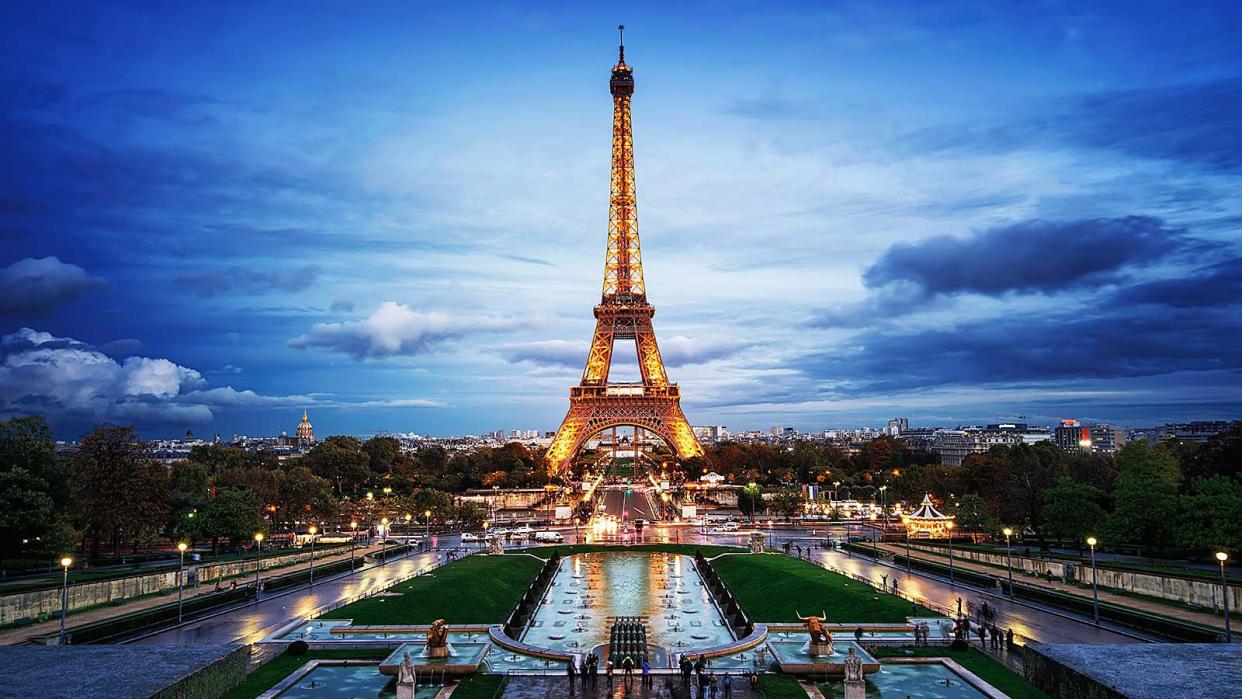12 Eiffel Tower Facts: History, Science, and Secrets in Paris

- Oops!Something went wrong.Please try again later.
Stanley Chen Xi/Getty Images
The Eiffel Tower—or as the French call it, La Tour Eiffel—is one of the world's most recognizable landmarks. The tower was designed as the centerpiece of the 1889 World's Fair in Paris and was meant to commemorate the centennial of the French Revolution and show off France's modern mechanical prowess on a world stage.
Mission: accomplished. The tower was built by Gustave Eiffel's civil engineering firm in two years, two months, and five days, using 7,500 tons of iron and 2.5 million rivets. The end result of Eiffel's hard work dominates the Parisian skyline and its stark silhouette has been emulated around the world in China, Las Vegas, Greece, and, of course, Paris, Texas.
Since opening in 1889, the Tower has welcomed over 300 million people and still welcomes almost seven million visitors a year. Despite the incredible number of people who have walked up the iron tower, there are still secrets to tell about it.
Related: The Eiffel Tower Just Got 20 Feet Taller – Here's How
There’s a secret apartment at the top.
When Gustave Eiffel designed his namesake tower, he cleverly included a private apartment for himself where he hosted famous guests, like Thomas Edison. The apartment is now open for the public to tour.
Gustave Eiffel didn’t design the tower.
While Eiffel earned the naming rights for the Tower, it was actually two men who worked for his company—Maurice Koechlin and Emile Nouguier—who drew the original design, according to Live Science. The two engineers teamed up with French architect, Stephen Sauvestre, on the plans for the monument and entered them into a contest to choose the main attraction of the World's Fair.
The Eiffel Tower was supposed to be torn down after 20 years.
As mentioned before, the Tower was built with the intent of showing off France's industrial prowess during the World's Fair, but the plan was to tear it down after 20 years. Eiffel had cleverly put a radio antenna and wireless telegraph transmitter in the Tower, and the government eventually decided it was too useful to demolish.
Hitler ordered the Eiffel Tower to be destroyed.
When Germany occupied France during the second World War, Hitler ordered that the Eiffel Tower be torn down, but the order was never followed through. French resistance fighters got their revenge, though—they cut the Tower's elevator cables so the Nazis were forced to climb the stairs to hoist their flag.
The Eiffel Tower is a cousin of sorts to the Statue of Liberty.
Before the Eiffel Tower was built, Eiffel's firm was asked to design the internal frame for the Statue of Liberty, a task assigned to his trusted employee, Maurice Koechlin. They proved their iron handiwork with Lady Liberty first.
There’s a post office in the Eiffel Tower.
Tucked into the first floor of the Tower next to the gift shops, there is a tiny post office. Pick up une carte postale and a stamp and have it mailed from the Eiffel Tower's post office and it will be delivered with the unique postmark.
The Eiffel Tower doubled as a scientific laboratory.
Mr. Eiffel housed a meteorology lab on the Tower's third floor where he performed studies in physics, aerodynamics, and built a wind tunnel. Eiffel opened the doors of the laboratory to other scientists to use for the experiments, too, and cosmic rays were discovered there.
The Eiffel Tower moves.
The massive iron structure is wind resistant and will sway during a storm. If the weather is bad enough, it can even move. Wind isn't the only thing that can make the enormous Tower move, though—the heat of the sun also affects the Tower, causing the iron to expand and contract up to 7 inches.
The Eiffel Tower is covered in names of scientists.
French scientists and engineers working in the 19th century were not forgotten by history—not only did they lend their names to Parisian streets, but 72 of their names are also engraved on the Eiffel Tower. The engraved tributes were covered up, but thanks to a restoration effort, they are once again visible and eagle-eyed visitors can see names like Foucault, Dumas, and Perrier cut into the iron.
It takes a lot of work to keep the Eiffel Tower looking good.
Every seven years, around 60 tons of paint are applied to the tower. It not only keeps the so-called Iron Lady (La dame de fer) looking good, but it also helps keep the iron from rusting.
There’s a military bunker underneath the Eiffel Tower.
Underneath the Tower's south pillar sits a snug bit of history—a secret military bunker that may connect to the nearby Ecole Militaire via a long tunnel. The bunker has now been turned into a small museum and tour groups can explore the diminutive space.
There’s a Champagne bar at the top.
If you're brave enough to reach the top of the Tower, reward yourself with a glass of champagne from the Champagne Bar built into the top floor. There's nothing like a glass of bubbly with a spectacular view.
No matter the destination, Travel + Leisure GO can turn your vacation dreams into reality. With nearly endless reservation options to fly or stay, book your next getaway — near or far — at Travel + Leisure GO.

